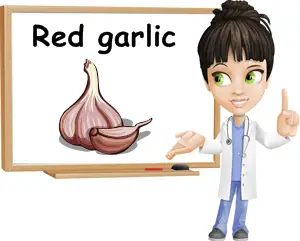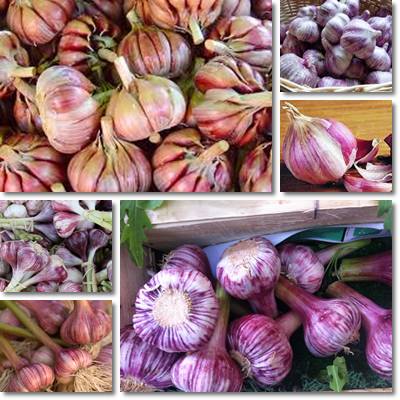Despite its particular appearance, red garlic is not a species of its own, but refers to any pink, red or purple variations of the common garlic species (Allium sativum). Red variations can appear in virtually any subtype of garlic and are visible in the papery skins covering each clove or in the cloves themselves. Red garlic is highly appreciated throughout the world not only for its interesting appearance, but also for its more pungent, richer flavor.
From a nutritional point of view, red garlic has about the same properties as the regular white variety and consuming it raw is pivotal for getting the full spectrum of nutrients it has to offer. Still, the beautifully pink, red or purple tinged garlic varieties offer a little extra antioxidant power in the form of natural pigments with various health effects. Overall, garlic is best known for its potent antimicrobial properties and healthy organosulfur compounds, notably allicin.

What does red garlic look like?
Red garlic is still garlic, except for the fact that the bulb, cloves or papery skins covering the cloves may be purple or red. You might see porcelain white garlic bulbs with reddish or purplish cloves (Romanian red, Parvin Georgian crystal), colorful bulbs with colorful cloves (Chesnok red) or colorful bulbs with white cloves. Some red garlic variations are tinged with bright purple, some have deep red blotches, while others are tinged with both a light red and a sharp purple, generally in streak patterns.
Generally, red garlic bulbs are symmetrical and bigger than white garlic bulbs, probably a preference of cultivators so the garlic is more showy. The number of cloves can differ greatly, from as little a 4 or 6 to 12 or over 20, while the colors appear in streaks along the lengths of the bulb. Just like white garlic, red garlic can be either softneck (a trait that allows them to be braided for a more fancy display) or hardneck (with rigid, upright stems).
What does red garlic taste like?
Red garlic tastes like garlic, but has a rich taste and a more robust flavor. Some varieties are so pungent they may make some people cry, but few have such a fiery flavor. Red garlic is often the first choice for hot sauces or spicy recipes not only because of its pungency, but also because of its depth of flavor. Most varieties grow well in mild climates and require well-drained soils. Fresh, red garlic can be stored up to 4 or 6 months. When baked, some red garlic varieties take on a pleasant, rich sweet taste.

What are the benefits of red garlic?
Red garlic has just as many benefits as the more common white garlic varieties. Its red or purple-tinged bulbs and cloves only indicate additional antioxidant properties. Here is a list of the 6 most impressive properties and health benefits of red garlic:
Rich in natural organic sulfur compounds
Just like white garlic, onions, red onions, shallots, leek or chives, red garlic too contains excellent amounts of natural sulfur compounds or organosulfur compounds (examples include ajoene, allyl polysulfides, vinyldithiins). Organosulfur compounds give garlic and onions their trademark pungency, but are also highly beneficial for human health. According to research, these pungent substance can offer protection against various forms of cancer, notably colon or stomach cancer.
Reduces inflammation
Regular consumption of garlic, red garlic included, has a strong anti-inflammatory action. Inflammation has been linked with the onset of various forms of chronic disease, notably cancer, obesity, heart disease or diabetes. Garlic works through various mechanisms to prevent dangerous inflammation levels which may endanger our health. One such mechanism is the action of vitamin C, a natural anti-inflammatory vitamin. Allicin, a potent compound in garlic and red garlic, has also been shown to exert a strong anti-inflammatory action.
Antibacterial, antiviral and antifungal action
Garlic in general is known as a natural antibiotic due to its natural antiseptic properties. The most potent compounds in red garlic responsible for the inhibition or bacteria and viruses are allicin, vitamin C as well as specific organosulfur compounds. All members of the garlic family convert alliin with the help of an enzyme called alliinase into allicin and release it when the cloves are bruised, cut, chewed or crushed. Allicin has thus a very short lifespan.
If not consumed almost immediately after the clove is cut, the great majority of allicin from garlic and red garlic will turn into organosulfur compounds. The antibacterial and antiviral actions of these compounds in garlic and red garlic has lead to their use for the treatment of common colds or even flu prevention.
What is interesting is that there are studies that support the use of garlic for treating the common cold. Finally, although garlic exhibits a natural antifungal activity in response to molds and yeasts that may cause it to spoil, if you suspect you have a fungal infection of the skin or any other type, it might be best to contact your doctor for adequate treatment.
Great cardiovascular benefits
Studies have shown that eating garlic on a regular basis or taking dietary supplements with garlic extract (this includes red garlic as well, seeing they are virtually the same thing) can help lower LDL (bad) cholesterol levels as well as slightly improve HDL (good) cholesterol. Moreover, research suggests that white garlic and its red variants boast considerable antiplatelet activity. This means that eating garlic can help reduce the risk of blood clots as it interferes with blood coagulation mechanisms. While for some people this may be a good thing, others who rely on anticoagulation medication should be careful with their intake.
Antioxidant properties
In addition to the strong antioxidant action of its natural sulfur compounds and good vitamin C content, red garlic also relies on its colors for protection against damage caused by free radical molecules. Though research is poor at this point, it is believed that the vivid purple or reddish streaks on the bulbs and cloves of various red garlic varieties indicates the presence of powerful anthocyanin pigments with strong antioxidant activity. All of these combined prevent too much damage to build up at the level of our cells which may disturb their normal activity and potentially cause them to turn cancerous.
Good source of vitamins and minerals
Red garlic has a similar nutritional profile to regular garlic and is thus a good source of important nutrients, notably vitamin B6 (1.235 mg, almost 100% of the recommended daily allowance for an average adult), vitamin C (31.2 mg), thiamine, pantothenic acid, manganese ( 1.672 mg), phosphorus (153 mg), calcium (181 mg), iron (1.7 mg), zinc and potassium.
Side effects and contraindications
Though incredibly healthy, red garlic has its disadvantages too. Just like regular garlic, onions, leek and several other problematic foods, red garlic too can be a source of several mild to severe side effects in particularly sensitive individuals.
Side effects may include bad breath, an unpleasant garlic body smell or other bad body odors (garlic makes sweat smell more pungent), stomach upset, acid reflux and heartburn, gastritis flare-ups, irritable bowel symptoms, mouth ulcerations and so on.
Some people are also allergic to garlic. It goes without saying that they should avoid red garlic as well and probably other garlic or onion family members which may contain the same allergens. Last but not least, garlic can cause skin burns when applied topically and may interfere with anticoagulant medication and some antibiotics, among the most common.
